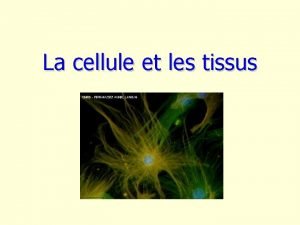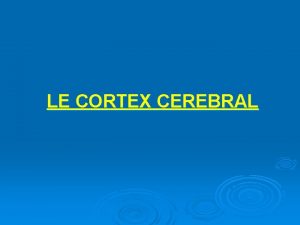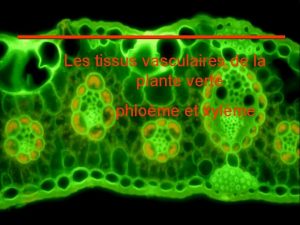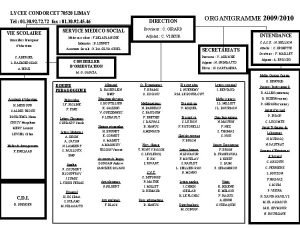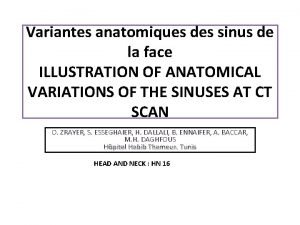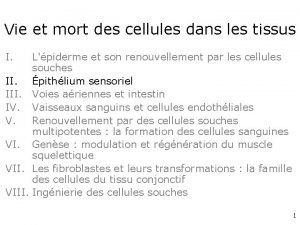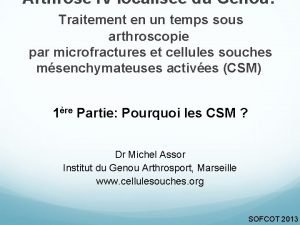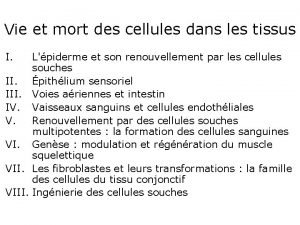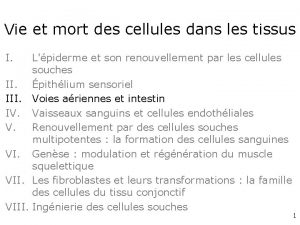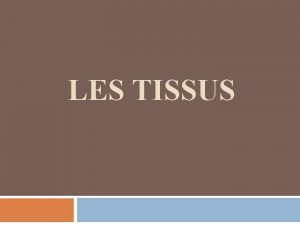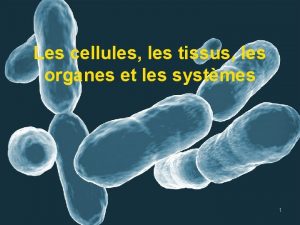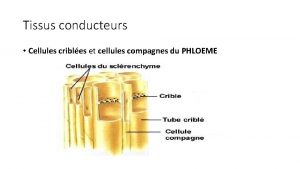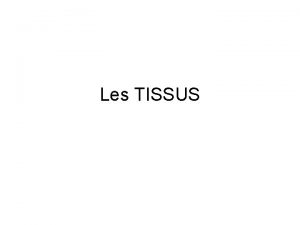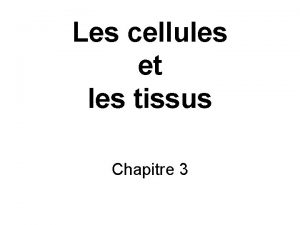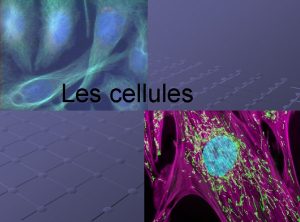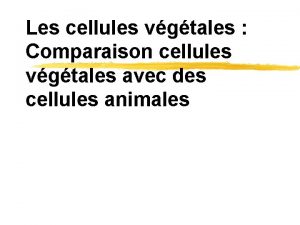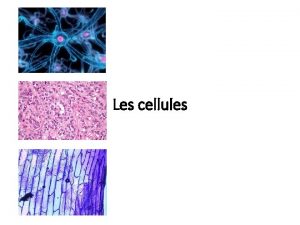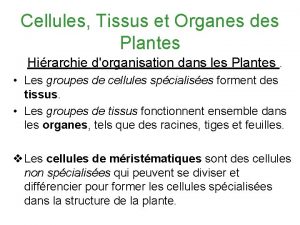Vie et mort des cellules dans les tissus






































- Slides: 38

Vie et mort des cellules dans les tissus I. L'épiderme et son renouvellement par les cellules souches II. Épithélium sensoriel III. Voies aériennes et intestin IV. Vaisseaux sanguins et cellules endothéliales V. Renouvellement par des cellules souches multipotentes : la formation des cellules sanguines VI. Genèse : modulation et régénération du muscle squelettique VII. Les fibroblastes et leurs transformations : la famille des cellules du tissu conjonctif VIII. Ingénierie des cellules souches 1

II - Épithélium sensoriel • Autre type d’épithélium qui recouvre notre corps • Tourné vers le monde extérieur • Sert d’organe des sens – – – Odeurs Sons Images (Saveurs Sensations) – – – Même origine embryologique : ectoblaste Comme la peau Structure de base commune Gènes de développement proches Organisation épithéliale… • Points communs • …mais organisation très différente de celle de l'épiderme ou des glandes 2

Organes des sens • Organes complexes • Réception d’un signal par un dispositif élaboré • Filtration et concentration du signal • Épithélium sensoriel • Arrive au système nerveux 3

Épithélium sensoriel • Composant clé de l’organe des sens • Petit par rapport à l’appareil qui le soutient • Partie la plus conservée pendant l’évolution (vertébrés et invertébrés) 4

Cellules sensorielles • Contenues dans l’épithélium sensoriel • Sont des transducteurs • Transforment le signal extérieur en influx nerveux 5

Les cellules sensorielles • • • Nez : neurones sensoriels olfactifs Oreille : cellules ciliées auditives Œil : photorécepteurs Sont des neurones ou apparentés Au pôle apical Structure spécialisée – Détecte le signal extérieur – Convertit le stimulus en potentiel de membrane – Synapse avec des neurones qui relaient l’information sensorielle à des structures spécifiques du cerveau 6

Organisation des organes des sens Axone Dendrite Axone 7

Organisation des organes des sens 8

Plan 1. Olfaction 2. Audition 3. Vision 9

3 – Vision • Épithélium sensoriel = la rétine nerveuse • Le plus complexe de tous les épithéliums • Organisation perverse : les neurones qui transmettent au système nerveux (cellules ganglionnaires de la rétine) sont les plus proches du monde extérieur : la lumière doit les traverser pour atteindre les • Photorécepteurs 10

La rétine nerveuse 11

• Structure de la rétine nerveuse • Lumière stimulation des photorécepteurs interneurones cellules ganglionnaires cerveau Fig 22 -14 • Dans les espaces libres il y a des cellules de soutien 12

Coupe histologique de rétine 13

Coupe histologique de rétine 14

Coupe histologique de rétine 15

Schéma de la rétine 16

Les photorécepteurs 17

Les deux types de photorécepteurs en fonction de leur forme 1. Cônes • 3 types • Avec chacun une opsine différente • Couleur et détails 2. Bâtonnets • Vision en faible lumière • Contiennent des rhodopsines différentes 18

Les deux extrémités du photorécepteur 1. Photoréceptrice enfouie dans l’épithélium pigmentaire – Article externe – Article interne 2. Axone 19

Article externe • Structure de cil modifié avec les microtubules) • Complètement rempli de piles de membrane où sont inclus les complexes photosensibles (absorption de lumière réponse électrique 20

Article interne 21

Axone • Synapse avec l’interneurone • Cellule ganglionnaire 22

Fonctionnement de la rétine 23

Neves G, Lagnado L. The retina. Curr Biol. 1999 Sep 23; 9(18): R 674 -7. Schematic diagram of the retina showing the principal types of neuron and their synaptic connections. Grey arrows indicate directions of information flow. Signals can pass from photoreceptors to ganglion cells through bipolar cells. Signals can also pass laterally, through horizontal cells at the first synaptic stage in the outer plexiform layer, and through amacrine cells in the second synaptic stage in the inner plexiform layer. Horizontal cells and amacrine cells modulate 24 signals transferred across synapses at these stages.

• The major cell types of a typical mammalian retina. From the top row to the bottom, photoreceptors, horizontal cells, bipolar cells, amacrine cells and ganglion cells. Amacrine cells, the most diverse class, have been studied most systematically in the rabbit, and the illustration is based primarily on work in the rabbit. Most of the cells are also seen in a variety of mammalian species. The bipolar cells are from work in the rat; similar ones have been observed in the rabbit, cat and monkey. For steric reasons, only a subset of the wide-field amacrine cells is shown. Richard H. Masland Nature Neuroscience 4, 877 - 886 (2001) The fundamental plan of the retina Fig. 1 25

Richard H. Masland Nature Neuroscience 4, 877 - 886 (2001) The fundamental plan of the retina Fig. 2 • • The bipolar cell pathways of mammalian retinas, assembled from individual components. This diagram is intended to emphasize the overall organization of the parallel channels, and much detail is omitted. Many primate retinas have midget bipolar and ganglion cells, but only a few have a separate red and green channels. Rods are not as clumped as would be suggested here. For visual clarity, cones are shown 26 contacting only a single bipolar cell each; in fact, all cones contact several bipolar cells.

• Richard H. Masland Nature Neuroscience 4, 877 - 886 (2001) The fundamental plan of the retina Fig. 3 The connections with cones and axonal stratification of different types of bipolar cells. Five different types of bipolar cells are illustrated. Two of them are diffuse (chromatically nonselective) ON bipolar cells terminating in the inner half of the inner plexiform layer. Two are diffuse OFF bipolar cells terminating in the outer half. Each samples indiscriminately from the spectral classes of cones. The blue cone bipolar, however, contacts only blue cones and thus is spectrally tuned to short wavelengths. Within the ON or OFF sublayer, axons of the bipolar cells terminate at different levels, 27 indicating that they contact different sets of postsynaptic partners.

Richard H. Masland Nature Neuroscience 4, 877 - 886 (2001) The fundamental plan of the retina Fig. 4 How transient (high-pass) and sustained (low-pass) bipolar cells decompose the output of a cone. The resulting high- and low-frequency channels can contact narrowly stratified ganglion cells ( a), in which case the two frequency bands are transmitted via separate, parallel channels to the brain. Bottom, a more broadly stratified ganglion cell (such as a beta cell) receives input from both types of bipolar cells. Such a ganglion cell (b) has a broadband response. Many such combinations are possible, as are many permutations of input from amacrine cells. 28

Richard H. Masland Nature Neuroscience 4, 877 - 886 (2001) The fundamental plan of the retina Fig. 5 • The types of ganglion cells identified thus far in the retina of the cat. 29

Richard H. Masland Nature Neuroscience 4, 877 - 886 (2001) The fundamental plan of the retina Fig. 6 The fundamental signal-carrying pathways of a generic mammalian retina, reduced to a conceptual minimum. Each type of bipolar cell (black) transmits a different type of information to the inner retina. The information that it transmits is determined by the bandwidth of the cones that it contacts, the number and type of those cones, the transfer function of the cone to bipolar synapse, and its interplay with amacrine cells. This is a minimal representation of the amacrine cells, which also include widefield cells and which have synaptic contacts among each other. The different types of bipolar cells are contacted by distinct types of amacrine cells, in a variety of synaptic arrangements. These converge upon the retinal ganglion cells, in which specific combinations of bipolar and amacrine inputs create many functional types of ganglion cells. 30

Richard H. Masland Elio Raviola Annual Review of Neuroscience Vol. 23: 249 -284 Confronting Complexity: Strategies for Understanding the Microcircuitry of the Retina A simplified view of the retina's structure. Most introductory textbooks present this view of the retina's cell populations, with only a little more detail on their synaptic 31 interrelations.

Richard H. Masland Elio Raviola Annual Review of Neuroscience Vol. 23: 249 -284 Confronting Complexity: Strategies for Understanding the Microcircuitry of the Retina A more complete rendering (Vaney 1997) of part of the retina's circuitry. This diagram is restricted to cells and synapses associated with the pathway from rod photoreceptors to ganglion cells, and even those are shown incompletely. (Simple contacts) Conventional synapses; (parallel lines) gap junctions. CB, Cone bipolar cell; RB, rod bipolar cell; AII, amacrine cell of that name; GC, ganglion 32 cell.

Rhodopsine • Opsine = protéine • Rétinal = pigment visuel 33

Thomas P Sakmar Nature Genetics 25, 245 - 246 (2000) Restoration of compact discs • • The rod outer segment, which contains rhodopsin and the biochemical machinery to convert a photon to a chemical signal, is embedded into the retinal pigment epithelium. Peripherin is an adhesion molecule localized to the disc rim, where it assembles to 34 maintain the structural integrity of the outer segment.

Renouvellement des photorécepteurs • Cellules permanentes qui ne se divisent pas • Pas remplacées si elles ont détruites • Mais remplacement des molécules de rhodopsine 35

Remplacement des molécules de rhodopsine • Continuellement dégradées et remplacées • Dans les bâtonnets (pas dans les cônes) turnover des molécules 36

Turnover d’une protéine membranaire de bâtonnet • Pulse de 3 H-leucine • Voisinage du Golgi • Base du segment externe dans un disque de membrane nouvellement synthétisé • Phagocytose par l’épithélium pigmentaire • 3 à 4 nouveaux disques / heure 37

Conclusion • La cellule persiste • Les molécules changent • Dans le corps très peu de molécules sont les mêmes que celles déposées chez l’embryon 38
 Il y a des moments dans la vie
Il y a des moments dans la vie Il y a des moments dans la vie
Il y a des moments dans la vie Il y a des moments dans la vie
Il y a des moments dans la vie Il y a des moments dans la vie
Il y a des moments dans la vie Classification des tissus conjonctifs
Classification des tissus conjonctifs Exercice physique
Exercice physique Les tissus ifsi
Les tissus ifsi Schema tissu epithelial
Schema tissu epithelial Je ne suis pas materiel je fais naitre et mourir
Je ne suis pas materiel je fais naitre et mourir Cortex homotypique
Cortex homotypique Cellules funiculaires
Cellules funiculaires Calorie dragibus
Calorie dragibus Les theme de la ficelle
Les theme de la ficelle La mort des oiseaux
La mort des oiseaux Dieu notre père nous aime personnellement
Dieu notre père nous aime personnellement Portrait moral de robinson crusoé
Portrait moral de robinson crusoé Michele torr pas bien dans sa vie lyrics
Michele torr pas bien dans sa vie lyrics La vie de david dans la bible
La vie de david dans la bible Exemple de fonction dans la vie courante
Exemple de fonction dans la vie courante Tissu nodal
Tissu nodal Tissu compartimental
Tissu compartimental Phloeme
Phloeme 4 types de tissus
4 types de tissus Des des des
Des des des Les valeurs des temps verbaux
Les valeurs des temps verbaux Cycle de vie des organisations
Cycle de vie des organisations Habits des paysans au moyen age
Habits des paysans au moyen age Conseil pour la vie
Conseil pour la vie Organigramme sbaa
Organigramme sbaa Cellule d'agger nasi
Cellule d'agger nasi Cellules malpighiennes parabasales
Cellules malpighiennes parabasales Logigramme automatisme
Logigramme automatisme Cellules sexuées
Cellules sexuées Cellules de renshaw
Cellules de renshaw Cellules ciliées régénération
Cellules ciliées régénération Reformer le cartilage du genou
Reformer le cartilage du genou Citation train de la vie
Citation train de la vie Les choses simples de la vie
Les choses simples de la vie Je crois que ce sont les petites choses
Je crois que ce sont les petites choses







